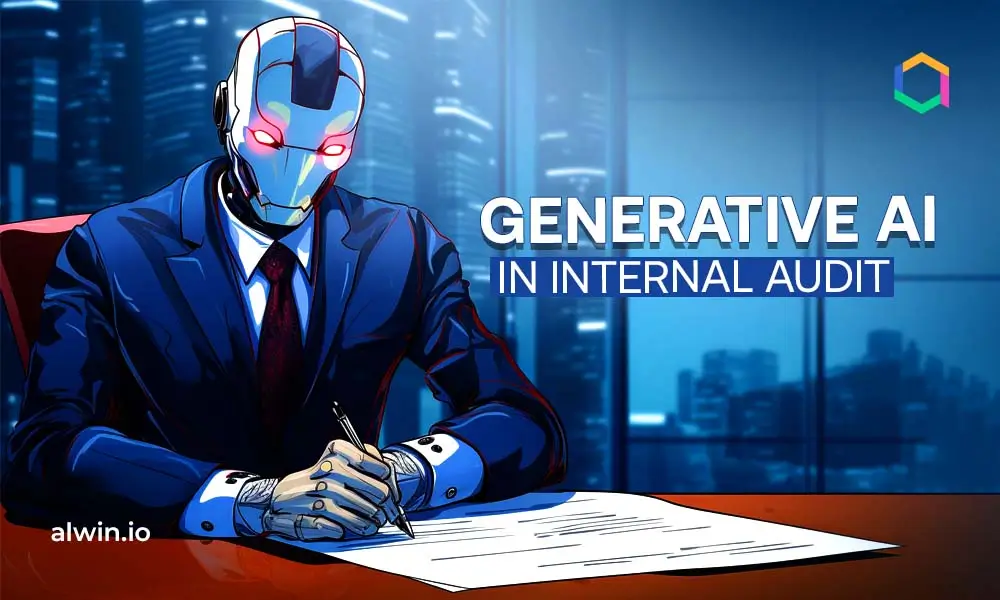Generational AI is making waves in the field of internal audit, transforming how organizations manage risks, compliance, and operational efficiency. Historically, internal audits have been labor-intensive, with auditors needing to analyze vast amounts of data manually. The process is being streamlined with generative artificial intelligence, as the tech can generate insights from massive data sets, revealing patterns and anomalies more quickly than ever before. Automating repetitive tasks allows AI to focus on more strategic, value-driven endeavors, enhancing both precision and decision-making.
A proactive approach to risk management can be offered by Generative AI's adaptability. Data patterns, potential issues, and even mitigation strategies are what this new tech learns from. The future of internal audits will be redefined by generative AI, providing companies with operational insights and a powerful tool for staying ahead in a highly regulated world.
Growth and Market Dynamics of GenAI in Auditing
The latest statistics show that Generative AI is rapidly changing internal audit processes. Companies believe that artificial intelligence will bring significant efficiencies to their audit functions, according to a survey by Deloitte. Increased data complexity and the need for rapid analysis to manage risks have driven the momentum around generative AI in internal audits. Over 80% of large organizations are expected to adopt or evaluate artificial intelligence for internal audits by 2025, recognizing its potential to automate routine checks, analyze large datasets quickly, and generate audit reports that would traditionally take days or even weeks.
The rise of generative AI in auditing also aligns with the business trend to reduce costs and enhance decision-making speed. Reports from PwC indicate that companies using AI-driven audits experience 40% faster decision cycles and are better equipped to identify financial irregularities, even those deeply embedded within vast datasets. The rise of generative artificial intelligence in auditing also aligns with the business trend to reduce costs and enhance decision-making speed. According to reports from PwC, companies using artificial intelligence-driven audits experience 40% faster decision cycles and are better equipped to identify financial irregularities, even those deeply embedded within vast datasets.
What is Generative AI in Internal Audit?
Generative AI in internal audit means using computer programs that mimic human language or answers to make auditing easier and faster. Simply put, think of it as a computer program that helps auditors handle lots of information, find problems, and make predictions. For example, an AI can quickly look at financial documents and find unusual transactions. This saves time and helps the audit team catch mistakes or fraud faster.
AI tools in auditing can process both structured and unstructured data to show insights, saving auditors time and letting them focus on making smart decisions. This kind of computer program can show different dangers and help companies prepare for possible problems. By implementing generative AI in audits, organizations can enhance the speed and accuracy of their audit procedures, thereby ensuring compliance with financial regulations and delivering timely insights.
Key Benefits of Generative AI in Internal Audits
Generative AI can help with internal audits by making things easier, and more accurate, and giving better insights. These are some important benefits
Data Processing Efficiency
Generative AI can quickly look at a lot of data. This helps auditors check financial documents, find mistakes, and handle a lot of written and unwritten information. This makes audit cycles faster and more complete.
Enhanced Risk Detection
Generative AI can find trends and red flags in historical data, which helps auditors spot potential fraud or compliance issues. This ability to predict risks is especially useful for identifying risks before they get worse.
Real-Time Insights
More accurate, up-to-date insights for management and stakeholders can be provided by generative AI tools. This enables quicker responses to unforeseen dangers and better-informed choices.
Cost Savings
The cost associated with auditing processes is reduced by automating routine audit tasks. This frees up resources for more strategic and complex tasks, which in turn maximizes team productivity.
Increased Accuracy and Reduced Human Error
With artificial intelligence's precision in handling complex data analysis, the chances of human error decrease. Generative artificial intelligence helps ensure that audit conclusions are both reliable and accurate by reducing these risks.
Scalability
Generative AI can handle the increasing complexity and volume of data without additional manpower, making it ideal for large organizations or those experiencing growth. This scalability allows audit teams to maintain high-quality audits without overstretching resources.
Generative AI in internal audits empowers auditors with advanced tools to improve accuracy, speed, and overall effectiveness, giving companies a stronger foundation for data-driven insights and long-term resilience.
Generative AI Use Cases for Internal Audits
Generative AI offers a diverse range of innovative applications for internal audits, assisting organizations in streamlining procedures, enhancing precision, and obtaining more profound insights. The following are some noteworthy applications:
Anomaly Detection and Fraud Identification
Generative Artificial Intelligence is capable of rapidly analyzing substantial volumes of transactional and behavioral data to identify unusual patterns or anomalies, such as duplicate payments or unusual user access patterns, which may indicate fraudulent activity. This proactive approach helps auditors identify irregularities earlier, which allows for faster investigation and corrective actions.
Automated Report Generation
Artificial intelligence can automatically generate audit reports by analyzing data and translating findings into structured narratives. By summarizing findings, risks, and potential issues, these tools enable auditors to devote less time to documentation and more time to strategic analysis and risk management.
Risk Assessment and Forecasting
Using machine learning and predictive analytics, generative AI can assess historical data in order to predict potential risk areas. By consistently monitoring and analyzing data, AI models can assist internal auditors in prioritizing areas with the highest risk, facilitating resource allocation and risk mitigation.
Continuous Auditing
Generative AI enables real-time monitoring of transactions, ensuring compliance with policies and regulations. By automating the auditing of ongoing procedures, AI equips audit teams with a current comprehension of operational well-being, enabling prompt responses to any detected issues.
Data Validation and Reconciliation
AI models are capable of handling repetitive tasks like data matching and reconciliation across systems, which are often time-consuming and prone to error. This facilitates data consistency and accuracy across financial and operational records, thereby reducing the duration spent on manual checks.
Policy and Compliance Checking
Generative artificial intelligence models can assist auditors in verifying the compliance of organizational processes with regulatory requirements. By comparing activities against regulations, AI-driven audits can identify potential compliance issues and help organizations stay aligned with changing regulatory environments.
Decision Support and Insights
In addition to reporting, generative AI can provide valuable insights into intricate data trends that may otherwise go unnoticed, thereby aiding auditors in comprehending more intricate operational patterns. For instance, it may highlight inefficiencies or areas of high expenditure that may warrant further examination.
Training Data Synthesis
Generative Artificial Intelligence can generate synthetic data sets for training purposes, enabling auditors to simulate scenarios without exposing sensitive data. This is particularly advantageous for instructing audit teams and evaluating AI models without genuine data integrity.
These generative AI use cases in internal audits streamline processes, enhance precision, and facilitate an evolving, proactive approach to risk and compliance management, thereby providing crucial value to organizations striving for greater transparency and operational resilience.
The Future of Generative AI in Internal Auditing
The future of generative AI in internal audit holds great promise, offering transformative potential for accuracy, speed, and strategic insight within audit functions. Auditors are likely to rely more heavily on AI-driven tools to conduct thorough, real-time analysis of complex financial and operational data as generative AI technologies continue to evolve. Internal auditing is one key area where generative AI is expected to make a substantial impact.
Auditors can forecast potential issues before they occur with future generative AI models that integrate predictive capabilities even more seamlessly. Enabling audit teams to focus on new risks and make data-driven decisions that align with an organization's strategic objectives will improve risk management.
AI will probably do most of the regular auditing tasks, like checking transactions, checking compliance, and making reports. This shift could allow audit teams to focus more on high-value analysis and strategic decision-making, which would make audit processes more efficient.
With AI-powered systems that check transactions constantly, auditors can check them right away instead of checking them periodically. This continuous approach allows for quick response to irregularities or deviations, ensuring compliance and minimizing risks.
Generative AI will become even better at detecting anomalies and patterns, so it can find fraud and irregularities more accurately. Machine learning algorithms can analyze historical data faster than traditional methods.
Future AI systems will help people make better decisions and give useful information. These tools are expected to work with auditors to analyze more data and apply their expertise to more complex and strategic areas.
As AI becomes more involved in auditing, its rules will change to meet the rules and be ethical. To use AI in internal audits, it's important to keep data safe, open, and accountable. This will help keep people trusting the company.
Generative AI will be used in internal auditing to combine automation and insight-driven analysis, which will make audit functions more resilient, adaptable, and efficient. This change will help audit teams play a more strategic role in helping organizations and managing risk.
Closure
As we conclude our look at generative AI in internal audit, it is clear that this technology is reshaping the auditing landscape, offering the transformative potential to streamline processes, improve accuracy, and enhance insights. Audit teams can take a proactive, real-time approach to risk management by continuously monitoring and adapting to evolving data and compliance landscapes with Generative AI.
Looking ahead, generative AI will continue to drive innovation in internal audits, helping organizations become more agile and resilient in an increasingly complex regulatory environment. A forward-looking internal audit or AI development team is crucial for companies looking to tap into this potential. Businesses can utilize this potential by collaborating with a Generative AI Development Company, crafting tailored solutions that align with their audit objectives.
Don't be afraid of the future, where better checks make your organization stronger and more resilient.



